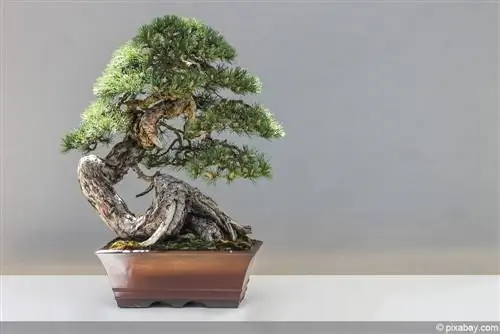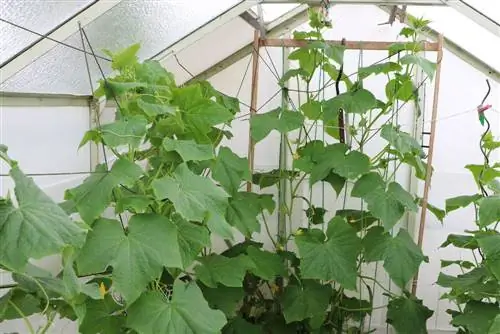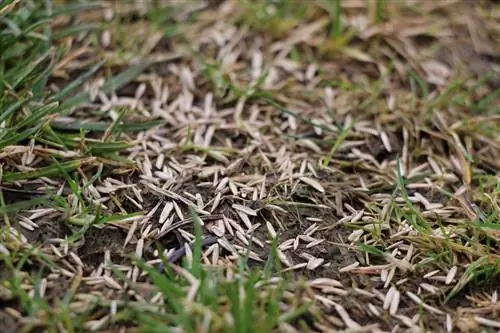- Author admin [email protected].
- Public 2023-12-17 03:39.
- Last modified 2025-01-24 12:45.
The American pampas grass (Cortaderia selloana) is also known as silver pampas grass and is considered a popular ornamental grass. The fluffy inflorescences look like magnificent feathers that are aesthetically moved by the wind.
Growing in pots
Pampas grass seeds can be successfully grown in a planter from March onwards. The species is dioecious and develops male and female plants that hardly differ in appearance. This makes it difficult to collect seeds in the garden, so you should use purchased seeds for propagation. Seed bags from the supermarket are usually not particularly fresh, which has a strong influence on the success of germination. Assorted garden stores offer more quality and ensure a better germination rate. Which container size you choose for sowing depends on the later use:
- small cultivation containers are sufficient if the grass is to be planted out later
- Large clay pots are ideal if container cultivation is desired
- Drainage holes in the base ensure that water does not build up
Use a suitable substrate
So that the seedlings do not shoot up, you should use a nutrient-poor potting soil. It should be able to store water without clumping together. High-quality products are germ-free and do not contain any weed seeds. To increase permeability, you can loosen the substrate with sand or perlite. Then add the mixture to your growing containers. If you want to cultivate around containers, follow these steps:
- equip large buckets with drainage made of pottery shards and stones
- fill halfway with potting soil
- then add a mixture of potting soil and sand
Note:
Make sure that the potting soil is free of peat. Good alternatives to conventional products are swelling tablets made from coconut fibers.
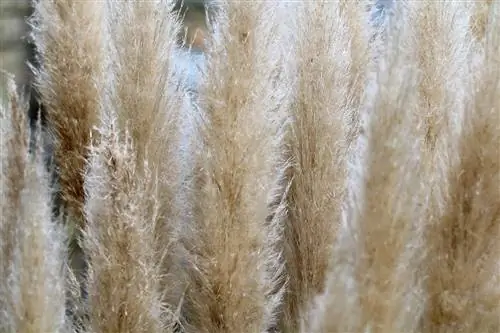
Sowing seeds
Pampas grass is one of the light germinators. The species originally comes from South America, where it reproduces successfully on alluvial soils with direct sunlight by falling seeds. Without light, the tiny grains do not germinate, which you should take into account when sowing. This is how sowing is done:
- Sprinkle seeds individually onto the substrate
- Tweezers make sowing easier
- Press the seeds lightly with a piece of wood
- Carefully moisten the soil with a flower sprayer so that seeds are not washed away
- Pull the foil over the planter
Select location
The seeds will germinate within the next 14 to 20 days if they find optimal environmental conditions. The seedlings prove to be sensitive to drought and frost. The ideal growing location offers warm conditions and sufficient lighting:
- Temperatures between 20 and 22 degrees Celsius are ideal
- Location should be bright
- Avoid direct sunlight
Tip:
These requirements can be met in mini greenhouses if you place a heated mat underneath and use plant lamps.
Care
To prevent seedlings from failing, you should keep the substrate continuously moist but not wet. Check the planters daily with your finger to see whether there is still enough moisture in the soil. If the top layer of soil tends to dry out, watering with a spray bottle is necessary. Remove the film every 24 hours so that enough air can reach the substrate and mold spores have no chance to grow. As soon as the ice saints have passed by in mid-May, you can plant the young plants outdoors.
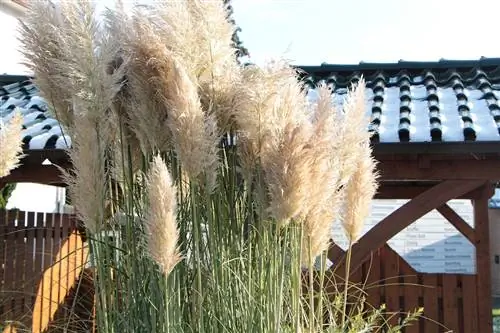
Sowing outdoors
The procedure for direct sowing differs slightly from growing in planters. Choose the location carefully, as pampas grass will grow into a dominant clump over time and take up a lot of space. In addition, the conditions at the place of growth should be sheltered from the wind so that the feathery fronds do not break off later. The sweet grass thrives in sunny or partially shaded areas that receive at least six hours of sun per day. Sowing takes place from mid-May as follows:
- Dig a hole and fill half with fresh compost
- Mix the excavated material with sand and put it in the hole
- Sprinkle seeds widely on the bed
- Press seeds carefully with a wooden board and moisten with a spray sprinkler
- Water the soil daily to prevent seeds from drying out
Tip:
The seeds are often eaten by birds. To prevent this, you should protect the bed with a close-meshed net immediately after sowing.


